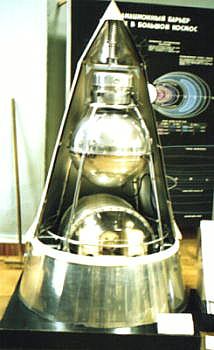Sputnik 2
2007 Schools Wikipedia Selection. Related subjects: Space transport
| Sputnik 2 | |
|---|---|
 |
|
| Organization: | Soviet Union |
| Major Contractors: | Korolev Design Bureau |
| Mission type: | Earth Science |
| Satellite of: | Earth |
| Launch Date: | November 3, 1957 at 02:30:00 UTC |
| Launch Vehicle: | R-7/SS-6 ICBM |
| Decay: | April 14, 1958 |
| Mission Duration: | 162 days |
| NSSDC ID: | 1957-002A |
| Webpage: | NASA NSSDC Master Catalog |
| Mass: | 508.3 kg |
| Semimajor Axis: | 7,314.2 km |
| Eccentricity: | .098921 |
| Inclination: | 65.33° |
| Orbital Period: | 103.7 minutes |
| Apoapsis: | 1,660 km |
| Periapsis: | 212 km |
| Orbits: | ~2,000 |
| Instruments | |
|---|---|
| Dog Laika: | Biological data |
| Geiger counters : | Charged particles |
| Spectrophotometers: | Solar radiation (ultraviolet and x-ray emissions) and cosmic rays |
Sputnik 2 (Russian: Спутник-2, Satellite 2) was the second spacecraft launched into Earth orbit, on November 3, 1957, and the first to carry a living animal - a dog. It was a 4 meter high cone-shaped capsule with a base diameter of 2 meters. It contained several compartments for radio transmitters, a telemetry system, a programming unit, a regeneration and temperature control system for the cabin, and scientific instruments. A separate sealed cabin contained the experimental dog Laika.
Engineering and biological data were transmitted using the Tral D telemetry system, which would transmit data to Earth for 15 minutes of each orbit. Two photometers were on board for measuring solar radiation (ultraviolet and x-ray emissions) and cosmic rays. Sputnik 2 did not contain a television camera (TV images of dogs on Sputnik 5 are commonly misidentified as Laika).
Mission profile
Sputnik 2 was launched on an essentially unmodified ICBM R-7, similar to that used for Sputnik 1, to a 212 x 1660 km orbit with a period of 103.7 minutes. After reaching orbit the nose cone was jettisoned successfully but the Blok A core did not separate as planned. This inhibited the operation of the thermal control system. Additionally some of the thermal insulation tore loose so the interior temperatures reached 40 °C. It is believed Laika survived for only a few hours instead of the planned ten days because of the heat. The orbit of Sputnik 2 decayed and it reentered Earth's atmosphere on 14 April 1958 after 162 days in orbit.
Passenger
The first being to enter orbit was a female part- Samoyed terrier originally named Kudryavka (Little Curly) but later renamed Laika ("Barker"). She weighed about 6 kg. The pressurized cabin on Sputnik 2 allowed enough room for her to lie down or stand and was padded. An air regeneration system provided oxygen; food and water were dispensed in a gelatinized form. Laika was fitted with a harness, a bag to collect waste, and electrodes to monitor vital signs. The early telemetry indicated Laika was agitated but eating her food. There was no capability of returning a payload safely to Earth at this time, so it was planned that Laika would be euthanized with a poisoned serving of food after about 10 days of orbiting the Earth. However, in October 2002 it was revealed by Russian sources that Laika had already died after a few hours from overheating and stress. The mission provided scientists with the first data on the behaviour of a living organism in the space environment.
Sputnik 2 and the Van Allen radiation belt
Sputnik 2 was not able to detect the Van Allen radiation belts as it traveled far enough to the north such that it was under most of the radiation belt while it was monitorable from the USSR. It carried no tape recorder. The Geiger counters did report an increase from 400-700 km but this was not interpreted as anything unusual. In Australia, Professor Harry Messel intercepted the signals but the Soviets would not provide the code and the Australians would not send the data. In 1958, with Sputnik 3, they began to cooperate and confirmed the findings of Explorers 1, 3, and 4.